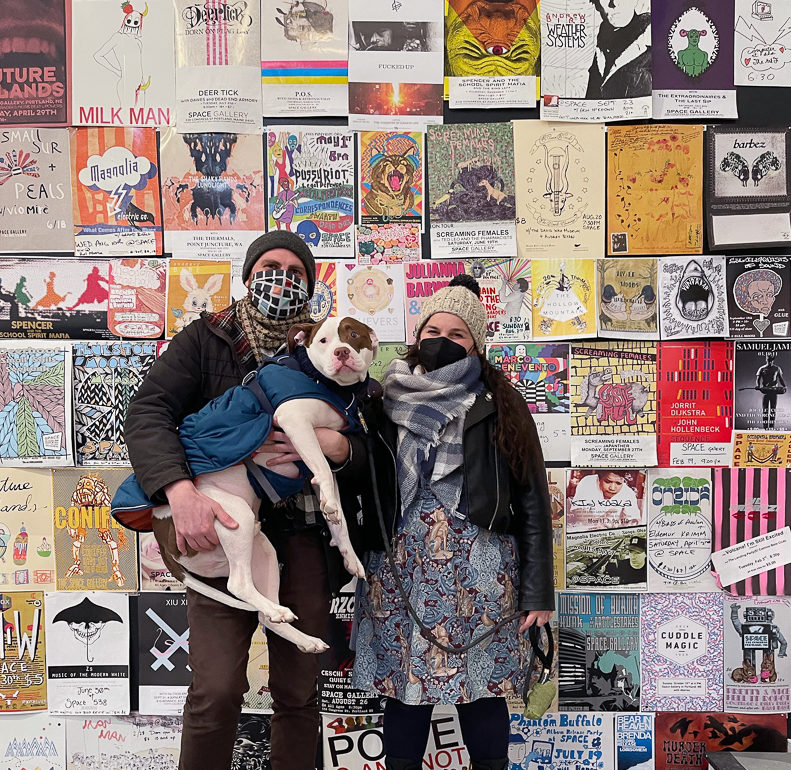In tandem with GREENROOM, our live music poster archive exhibit in the gallery, we talked with local artist and former SPACE staff Kris Johnsen about art for music, collecting, and local Portland history. Be sure to visit GREENROOM on exhibit through April 23rd, 2022.
Describe your history with SPACE
After graduating MECA in 2008, I was working at Art Mart, which used to be next door to SPACE. I knew I had to do something more in town, and I knew Ian Paige, the events programmer on the event staff, a little bit, he would come into the art shop and get coffee. I remember this specifically, he came in and got coffee then came back to buy a paint by number kit for someone and I just briefly asked him, ‘if you ever need help over there’… I was thinking of volunteering, sit in the gallery for a few hours every week or something, cause that’s all I thought they needed. I didn’t realize at the time he had just started that position, and I think in his head he was like ‘you’re gonna be my intern’ so we met a few days later and I was his intern. I don’t need the credits because I was out of school but it was something that seemed super fun to do and I learned a ton. I was the Events Programmer Intern for a year maybe, and then I just didn’t leave. At the time there were other interns that came and went, they treated it very much like an internship with a specific timeline. But I would just go in whenever I could, I liked hanging out there. It became just a natural progression, at a certain point the interning slowly stopped and I started working the events, mostly doing door. Bartending sometimes, house managing sometimes, that was a little stressful so I didn’t enjoy that as much. I really liked to work the door cause you got to interact with a lot of people, I really liked that. Once I started working at SPACE and realized people had come in and done posters for events, and right at the moment I happened to come in no one working here was fully doing that. I found that as my niche where I could contribute. So throughout that whole transition I was doing posters, even when I was working the door I would still do that stuff. Which was great because I met tons of musicians coming through, and artists, and later on would do real jobs for them. A lot of the posters were real jobs but it was more on a whim, I’d do it for free, and we’d split the profits that night. Eventually I figured out different ways where it wouldn’t cost the band any money and I would use my time and some supplies but we could both benefit from it. I tried to make that as equal as I could cause you can’t just make artwork of the show and sell it on your own. I would keep some for myself too but I would always make sure that was ok with the bands. A lot of time I would give them a chunk to take with them that they could sell. It was always very friendly and even. I was also writing up a lot of blurbs and finding photos and listing stuff on the website. At the time it was pre-Instagram so we’d make really long blog posts about stuff and that was one of my jobs. Posters just came along with it to promote shows. I started out with small digital things that weren’t meant to be screen printed, just small handbills. Those weren’t super artistic, just to get the word out fast. From there it built a little more into, ‘oh I could do something more with this’ or ‘these people, these bands are local, I could just message them and ask them ‘can I make a poster or do you have a poster or an idea and we could make something bigger out of it?’. I remember the first bigger printed poster I did was for a Johnny Cash cover night. It’s a big picture of him I took from the internet. Its two colors, pretty simple on cheap paper, and it was just pulled together too. I think I just made it digital, something small and Ian was like ‘you should print that!’. I already knew how to screenprint, not really well, but I knew how to do it and I had the materials, so we blew it up and printed posters and I think we kinda sold them, kinda gave them away that night for like $5 each just to cover costs and that really sparked me. Everyone who performed got a free poster, and I remember seeing how excited they were. It was barely my art, but it was something that led to ‘I should actually make these better now that I can contact these people, or feel comfortable doing that’- most of them were over the moon, excited that someone would want to do a poster, because a lot of the time it was people who were not humongous names necessarily. They were just psyched that someone wanted to make a poster and I tried to do that. I started collecting my own, collecting anything anyone else was doing, collecting digital ones, at the same time other people were making posters, I wasn’t the only one. Reuben J. Little had done a ton of posters, he was doing posters at the same time, Zach Howard, there were other people, they just didn’t work at SPACE. They were in bands doing their own thing, so I definitely looked at what they were doing too. I collected a lot of their posters anytime I could, and then eventually got to know them and hung out with them and printed a couple posters with them, it was something we had in common. I don’t remember the year I stopped but I worked there for about 4 or 5 years. A lot happened in those years, it feels like ten years. I met some of the best friends that I’ve ever had, still great friends, I met Jess, my partner, working events, we’re still together 12 years later. That’s my history at SPACE. And I’m still in the artists’ studio building upstairs, I never really left. I moved into the studio building the same exact month I started interning.
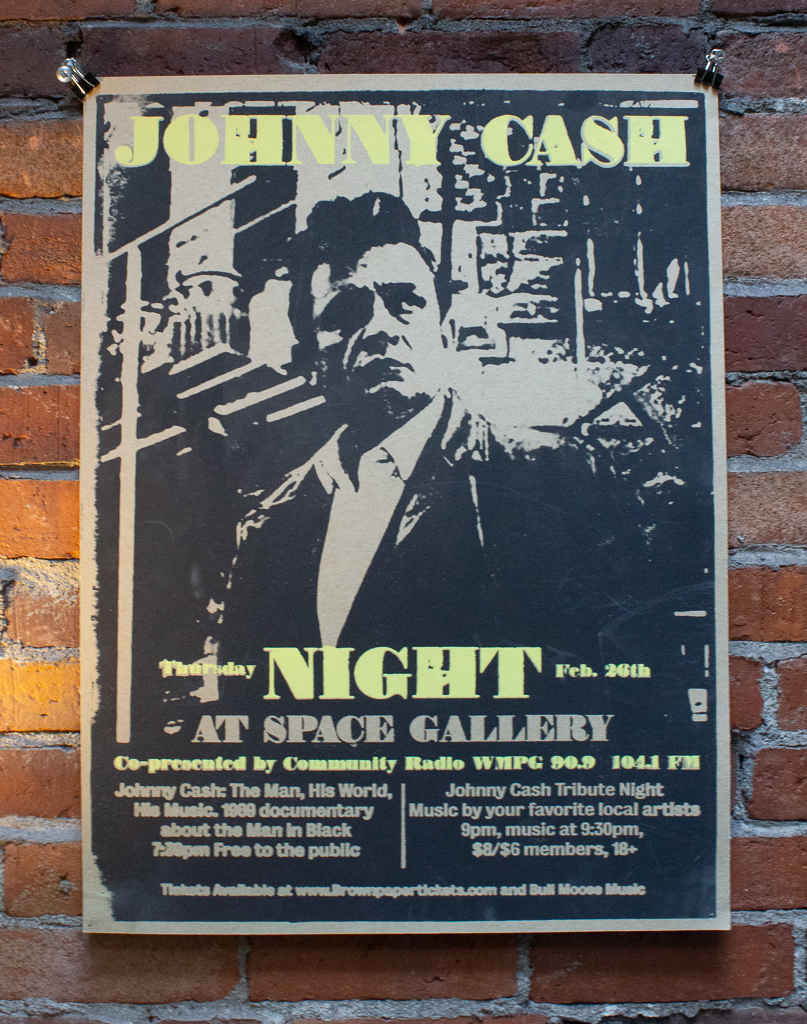
What is your experience of making artwork for a musician or a show? Is that process different from the other creative work you do?
It’s changed over the years. It first started out just me. I had a lot of time, I worked at the art store, I was working in my sketchbook all the time. At the time my sketchbook was pretty complete I would say, pages were finished pieces, but they were still in the book so I would just scan the book and collage it around, mess with it in Photoshop and drop text all over it, try to curate it for the show. It wasn’t necessarily an image I would create for something specific, that’s just how it started out. I would say the first two years that’s how I started making event posters. It’s changed over the years where now I’ll specifically design things for whatever the job is, not just be like ‘image, text, done!’ which is not a bad way to go about it too if you’re an artist who has a lot of back stock you’re just grabbing from, something that hasn’t been used yet. But now, everything is new, I don’t have as much sketchbooks to pull from, as I’ve gotten older I’ve just had less time, and my sketchbooks aren’t what they used to be. Now my sketchbooks are sketches for a finished piece, a lot of pencil sketches- not finished paint or marker work. Because I used to work at the art store which was literally next door to SPACE, I would just keep used pens, we would have pens to make signage and stuff and I would use them in my books, which was ok. I would use a lot of merchandise that got damaged too. I used to use coffee a lot instead of ink, we had a coffee shop in the art shop so I’d drink half my coffee then paint with it.
Andrew Scripter made a poster for GREENROOM that incorporates AR, how do you use technology in the work you’re doing? Has that changed over the course of your career?
It hasn’t changed a crazy amount, I still do a lot of things by hand. I usually sketch things out, make drawings, make different layers and textures. I typically build whatever the final image will be in Photoshop. I use InDesign a little bit for text and other straight line layouts. I don’t finalize everything in InDesign, I don’t really use Illustrator at all, it just never clicked with me in the same kind of way, I think because I wasn’t drawing on a computer or tablet. That process stayed the same for a while; usually hand work, then into the computer, and then back to hand done because I always printed everything myself, which most of the time was screenprinted. Now I’ll do giclee prints or digital prints, which I still print myself in my studio, I don’t send those out. I always liked that it was hand, into the computer, printed back to hand, burning the screens myself. It all stayed within my studio which I really liked. It’s less exciting for me to send something away to get printed I guess, and it was always a money thing too so I’d do it myself a lot of the time. Even though it takes your time it’s still cheaper in the long run. A lot of the old posters were all made on chipboard or some cheaper craft paper, same thing, there was no budget for these things so you use what you can.
I noticed Thee Silver Mt. Zion poster on the timeline wall in the gallery is actually printed on the back of the cover of a pad of paper.
Yeah, it’s a blank piece of paper, why not use it? My friend Reuban would do that too, at the art store we would get things packaged inside other papers and chipboard. I would always save that and it was fun to use it. Printing on something you wouldn’t normally print on like different color paper or craft paper, you’d get something else out of it than just printing on white paper. Starting on a white sheet is hard, I never enjoy white paper. Similar to having a giant canvas, it’s very daunting to turn it into a finished thing. Lately I mostly print on black paper.
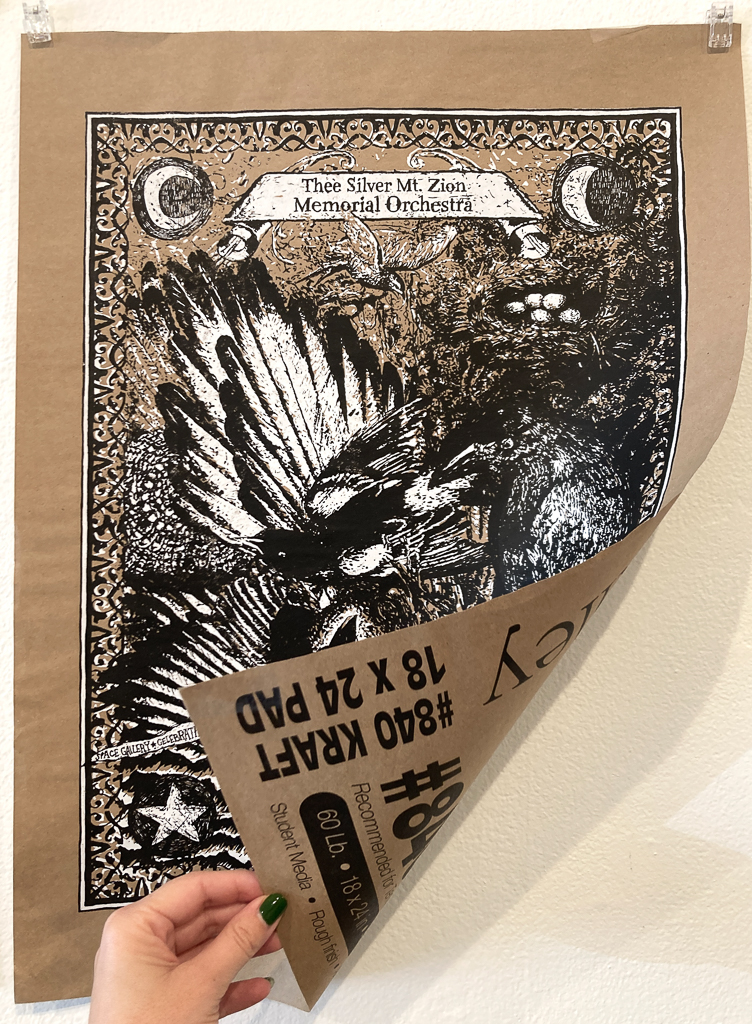
Like there’s already an element laid down, the first choice has been made?
Maybe, yeah. It’s already started with something.
In the back room of the gallery there is a display of photo documentation of some printwork you did with Lady Lamb, the musician Aly Spaltro, for her show “Farewell For Now, Lady Lamb” Extravaganza Can you talk about that?
We had always been friendly because she was a musician in town and I was an artist in town and when she started I was working at SPACE. That poster wasn’t our last thing but it was when she was moving out of town so she wanted a bigger project. The idea came really fast I think and we had the idea to make two of them that we could print up at the same time so it was like we printed one poster but we could have two different images that was twice the fun I guess. Some of them we kept together so people could have both and some we split. We hung up a lot and had some for sale at the show. As far as the collaborative part there, I remember she had a bunch of drawings already done and then I drew most of the layout and popped her imagery in. We printed them at Pickwick upstairs, and just hung out together printing posters. It was pretty casual, we all just had more time back in the day. It’s nice for friends to just stop by and help print the thing that they’re a part of. I just wanted to help out with promoting the shows or make something special to remember and obviously a lot of people remember that Lady Lamb show, I’m sure but the poster definitely helps, or that documentation helps, because otherwise that stuff gets a little forgotten.
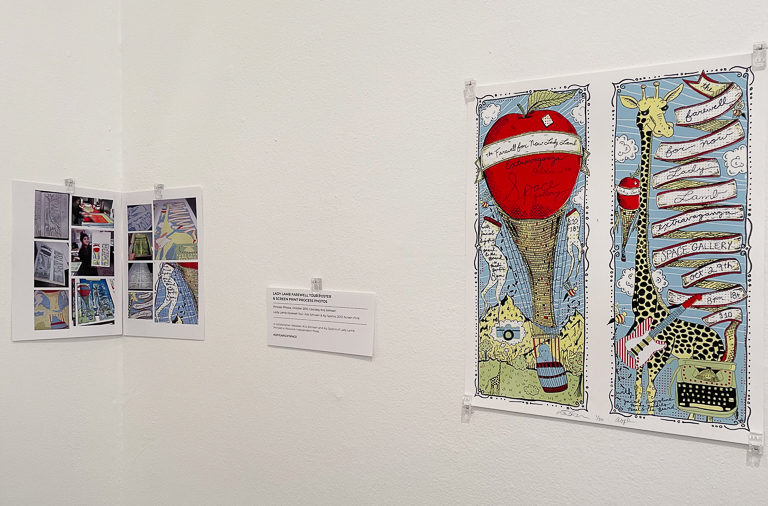
Especially then, that was 2011, we all had cameras but not camera phones. I always had a small point and shoot digital camera that I used to document everything, take photos of all the process stuff. At the time I had a blog that was basically like an Instagram, each blog post would be lots of pictures and more well written pieces, not just ‘here’s this thing’. I used to be really into that, anytime I would finish a project I’d go through the pictures and put them in order from start to finish and do a write up about why we’re making that poster or write a little thing about it. I really enjoyed that at the time, I don’t keep the blog anymore for time’s sake I guess, it takes a lot of time and blogs don’t get that kind of traction like they used to at all. It slowly faded away I think. I don’t look back at the blog often but it’s still online, it’s still relevant in a way. It’s not relevant in that it’s new or current, but it’s kind of a history of my career, a very specific part which is also kind of interesting. Aly and I have gone to do other small projects together like t-shirt designs and a few other posters, one recent at The Hive which is her place, she did some small shows and I did the poster for that which is all her artwork. I’d say a lot of it is usually her artwork. I think that one in the gallery is different because it was mostly my artwork. I enjoy printing other people’s work when it’s interesting to me and when they are invested in the thing they’re doing. People are artistic in many ways, I don’t play music, I never have, I wish I did, so I understand some people play music and they don’t make visual art so it’s nice to help out there.
GREENROOM is an archive exhibit and you were our primary consultant for this show, many of the pieces on display here are not only of your design but also on loan from your own collection. Can you talk about your process and values of archiving work and collecting art and printed material?
That’s something I think about a lot. I have always collected, a lot of music related things when I was a kid. I collected CD’s, I would buy CD’s all the time, I’d go to shows and I would save the flyers. I used to go to the Warped Tour a lot and back then you got a lot of free stuff, samplers, people trying to promote their stuff, free stuff is always cool, I would come home with a backpack every year of samplers and I’d save them. I’ve gotten rid of some things, most of the CD samplers- but they’re all on my computer if I need to reference them. Eventually keeping a lot of stuff is a lot, and heavy. Flyers I still have a lot of from high school and early college that I’ve kept. I’d say it’s the reason I became an artist. I think everyone thinks about that- some people have exact moments ‘that’s the reason I became an artist. I feel like I have a few, one of them is definitely Calvin and Hobbes and the Far Side books. As a kid having those and enjoying them, they are very artistic. That was an early part, after that it was CD artwork, buying CD’s based on the artwork. I’d go to Bullmoose in Portsmouth once a week and get a CD because I had disposable income then. Sometimes I knew exactly what I was buying, sometimes I would kind of risk it, I’d go in the realm of ‘this band might be like that band so I think I might like it’. CD art was huge, some of my favorite artwork is album artwork, and eventually I started to buy records and appreciating it a little bit more. Getting my mother’s record collection, which has bigger artwork and older work, seeing that this stuff had existed before. In high school you’re just in the now, I’d want to listen to bands around now. As you get older that broadens to seeing all this artwork, music and visual art exists. So music was huge, band t-shirts, I always viewed that as art, is it high art? Not necessarily, but is it super memorable? Definitely. Some band t-shirts- especially now that stuff is becoming very sought after- Metallica t-shirts go for hundreds of dollars cause they’re so fucking cool, they were making really cool shirts in the ’80’s and they still are and there’s other bands doing that. I was always really into that. I think at a certain point it clicked that ‘oh I could do that kind of artwork’. I’m not so far off that it’s not unattainable to design a shirt for a band or an album cover. It’s still hard and you have to make the right connections and find the right way your art fits in that world, I’m still working on that, it’s not happened and done, it’s still a hustle and I’m striving to do more artwork. At the same time as all that I was collecting these things and eventually moving to Portland, going to art school, I wouldn’t say I collected a ton during that part, I was making more and more. But I kept collecting and it was something I enjoyed doing, and now looking back, that happened and I still collect but not in the same way, not everything. It’s interesting that I did that for a while because I’m not an archivist. I think that would be very fun to do as a job, but it’s a very specific time in Portland history, and I’m glad I saved stuff. Because otherwise, I know people have it, but it’s so spread out, to find everything would be hard. And I know there are things I don’t have in my collection that are around too. I didn’t save everything, maybe because I just didn’t get one.
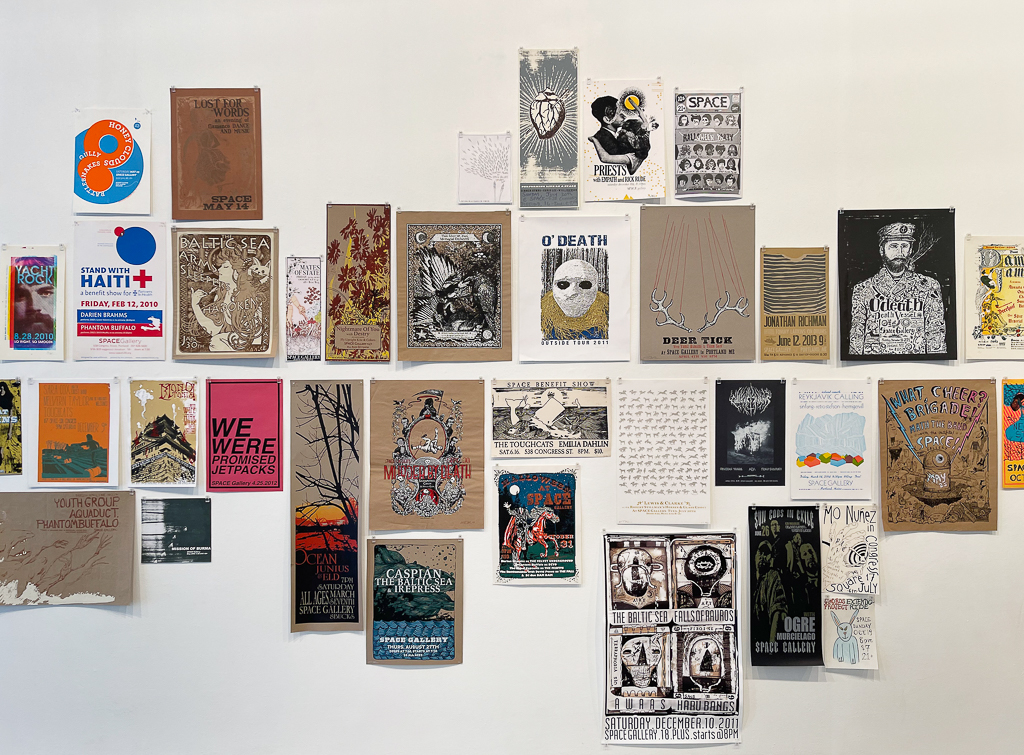
It was super fun to dig everything out for this exhibit because a lot of stuff is familiar to me. I enjoy seeing other peoples’ work cause I’ve seen my own artwork enough, it’s not as exciting, but seeing other peoples work hung with mine is really nice, and a lot of the back wall in the gallery I’ve never seen, a lot of that predates me being here, that stuff was somewhere in SPACE but we didn’t take that stuff out because SPACE wasn’t old enough to do something like this yet.
In the digital age we have found ourselves in, what do you think of printed ephemera as promotional art?
It’s changed for sure. There was two ways I was looking at it: I was making things to promote a show with ahead of time, but in the last ten years sometimes you wouldn’t even see the poster someone created until that night that you went to the show. It was less about promoting something and more a piece of merch, something to remember that night. Which I don’t have a problem with, it’s just a different way to do something I guess. I don’t know if I’ve ever created a poster that wasn’t out there before the event and had the price and time of the show on it. But recently posters that come out don’t have that information, it’s still a gig poster, it’s just a different purpose. It’s another world that I’m not necessarily a part of. I have definitely stopped making gig posters over the years, it just slowed down at a certain point. I started doing more art prints and things for myself. Not necessarily for other people or bands. The SPACE connection too, once I didn’t work here it got a little harder, I didn’t have the in as much as emailing people and cold calling, which I didn’t enjoy as much once I left. That was ok, I still do a lot of art for bands, but it might not be a gig poster, it’s a t-shirt or a couple album things over the years. That’s never been the main focus. I think I just liked to transition to doing art for myself. I don’t think art has changed as much with promoting shows, it has just changed platforms. When I started blogs were a huge thing. That’s not that different from Instagram, everything has just gotten a lot simpler and faster, I don’t know if any of us really enjoy it, it’s a lot. It’s a lot to keep up with. It’s harder now to promote something, it’s really hard. As an artist, as a musician, everyone is having that problem. I don’t want to sound like an old person, I still really enjoy being in that world and using the computer to your advantage, but it has definitely changed. It’s hard to promote events, for sure, I’m sure you guys find that too. You can post something a million times but that doesn’t mean people see it, people don’t go to websites much anymore, which everyone has websites, they’re there, but it’s harder to get things across. One reason for making a big poster is to hang them up ahead of time. Portland used to have poster boards all over the place, they don’t really exist much anymore. You could hang up a big poster and it felt ok. People would cover up posters fast when there were events, but that’s how it goes.
Your poster for the Mount Sharp show in March 2020 is the marker on our gallery timeline noting the beginning of the pandemic, a show that the art was made but the show was canceled. In that early shut down of events and commissioned orders getting canceled, what were your thoughts at the time about how printmaking would be affected, and how you would carry through?
I had a lot of friends on that show so I wanted to make the poster. The show was scheduled for the following week and things were getting weird in the world, we didn’t really know what was happening. I was supposed to see Against Me! at Port City that week, things got weird fast, and I didn’t go to that show. We weren’t sure how to have fun. The Mount Sharp show got canceled that day too. I just thought ‘I’ll hang onto these posters and in a month when we have the show I’ll just print over the date. ‘ That was the impression in my head. Two years later I still have the stack of posters in my studio. It wasn’t just me, every artist I know sales’ just stopped. Any artist who did wholesale, which is a very big part of my income, just stopped. Because all the stores closed, and at that point the only income anyone had was mailing art to people, and then the point came when the mail through the post office was at risk, so everything blew up. But I’m still here, I made it through. We’re still feeling it, things have not bounced back. My art has always been tied to bands and music, it’s what I enjoy. I always viewed my art and projects as a record label, when I work with artists I don’t make artwork for my brand. I treat it like it’s still their art, I’m just helping put it out there in the world. There was a change in the pandemic where bands were putting out a lot of merchandise because they couldn’t tour, but it was also really hard for them to find the money to make the merch. It’s coming back slowly. I definitely kept doing my own thing, hoping that it bounces back.
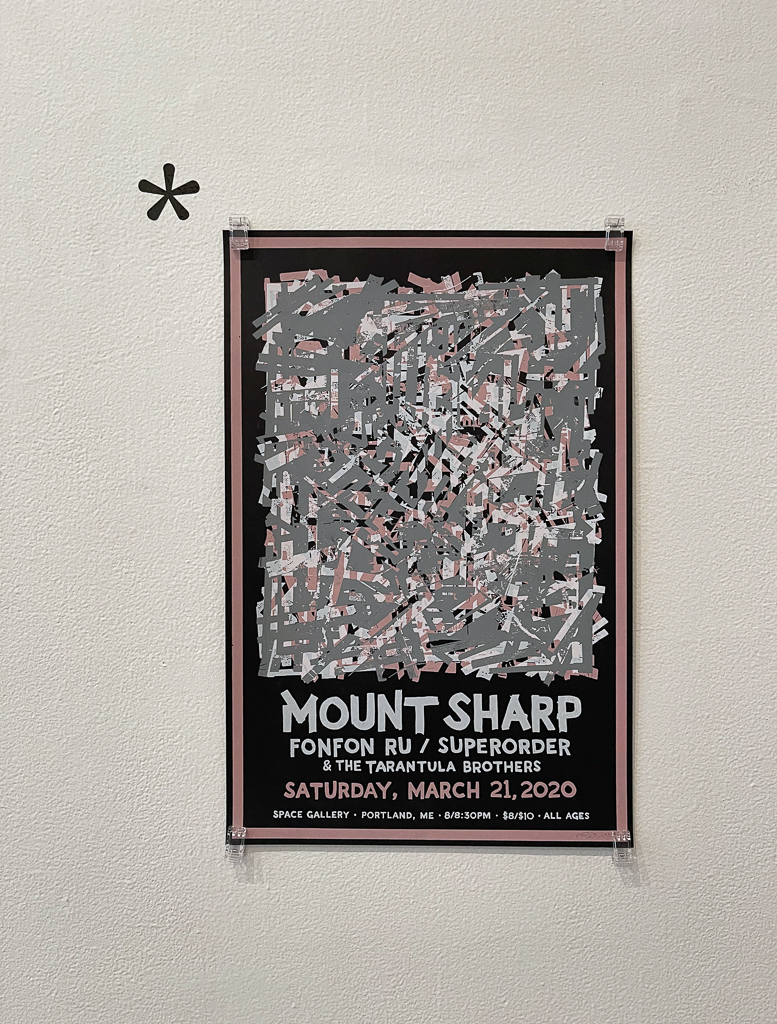
You had auctioned off some of your original artwork during pandemic closure to raise money for Save Our Stages and The Apohadion.
Lauren Wayne at the State Theater spearheaded the Save Our Stages initiative and at the time I had no money to donate to these things, but I had posters. I made the original poster for the State Theater reopening in 2010, My Morning Jacket played. Those posters were long gone that night, they sold out, but I saved two. The poster was just sitting in a box at home so I gave that to auction off. I hope it made them a little bit of money. A lot of people couldn’t help with money but could help in other ways. And I had done some album art for Greg Jamie’s band Blood Warrior a while ago and I had a little piece so I said ‘let’s auction it off so the Apohadion can pay the rent’.
I bought that Blood Warrior piece.
Did you buy that? Thank you. That seems so long ago. That piece was just on my wall in my studio, I never really knew what to do with it. Sometimes I don’t feel comfortable selling some things when it’s a piece that was for an album cover. I tried to do what I could, but Greg had some records to go with it. Other people did similar things too, small things to try to help out because venues were closing. Port City closed, the Against Me! show I skipped was the last show at Port City, which is a bummer. That was a great venue, and now that size room doesn’t exist in Portland, and now we’re missing that. But I’m really glad Arcadia opened there. That’s the best thing that could have gone in there.
Do you have a dream musician or musical festival that you would want to make art for?
That’s a tricky question cause I feel like if I say the name it won’t happen. There’s so many artists that I love, not necessarily all of them are ginormous artists that I want to work with. I feel like I always got more out of up and coming, hard working artists, that I also enjoy. Sometimes it is hard to make work for music you don’t feel a connection with, I’ve always struggled with that. Choosing art as a career is slightly selfish in a way, you’re just trying to please yourself and there’s an aspect to it that’s like “look at this thing I did, look at this thing I did, look at this” and it can be very tiring. But I enjoy making art and I enjoy collaborating, my favorite posters have been collaborative processes, even if it’s mostly my art but it has someone’s hand in it, and event posters are even a collaboration because it has someone else’s name on it. Whose poster is it? Is it mine, is it theirs? Who cares? As long as the project was fun and also made with the best intentions and not made without them knowing. Because that does happen in the art world. So I’ll say Godspeed, but I made something for Thee Silver Mt. Zion so that’s almost there. But they also do mostly their own artwork so I almost wouldn’t want to step on their toes.
What are your favorite posters in this exhibit?
I’d say the funnest piece I did was the Screaming Females one, that one was super collaborative, but in a funny way. They had come through SPACE a few times, I had done projects with them more offering to make posters for them and they were like ‘great’ cause they’re super nice people and love when people make posters for them, they seem very into that. Every time they came through town it was like the best show that’s ever happened in the world. I had met Marissa Paternoster and I love her artwork and her bands so I was just writing up the blurbs and I wanted to do a collaborative poster cause her artwork is so good. I remember emailing her and asking if the three bandmates could do an Exquisite Corpse, because I knew Marissa did art, I didn’t know if the other band members did but like, who cares? It’s probably just gonna turn out weird, and that’s good. I said just send it to me, I’ll scan it and colorize it, turn it into a poster and it’ll be awesome. I’ve never seen that done, I still haven’t. She got back to me, was super nice and said “we’re on tour right now, we don’t have time to do that, it sounds awesome, how about I just send you a ton of my artwork, and you just do whatever you want with it?” So she sent folders of her artwork, a lot of black and white, she told me to do whatever I wanted, so I did. The main part was the drawing and then I extended stuff and added some of my own drawings. It’s a hodgepodge of both of our work, and I think they were really psyched with it. The reason it has sharpie writing on it is because I tried to make it without SPACE show text so they could have a bunch and take on the road to sell so it’s a band poster. For the local ones I handwrote the show text so each one is a little different, which I was fine with. That one was so fun and we sold them at the show. I don’t have vivid memories of the show but I remember that project was really fun and it was so nice to interact with someone that was on the same page. Visually I like it, I like that it’s not all my artwork, it’s someone else’s that I interpreted a bit. I tried to use the brightest colors like ‘Bam! This thing is bright!’ or ‘It’s ugly!’, and gets people’s attention for good or bad. Definitely one of my favorite posters I’ve had a part in. And it’s big, I like that, I never made posters much bigger than that, so to me that’s a lot of work to print those by hand.
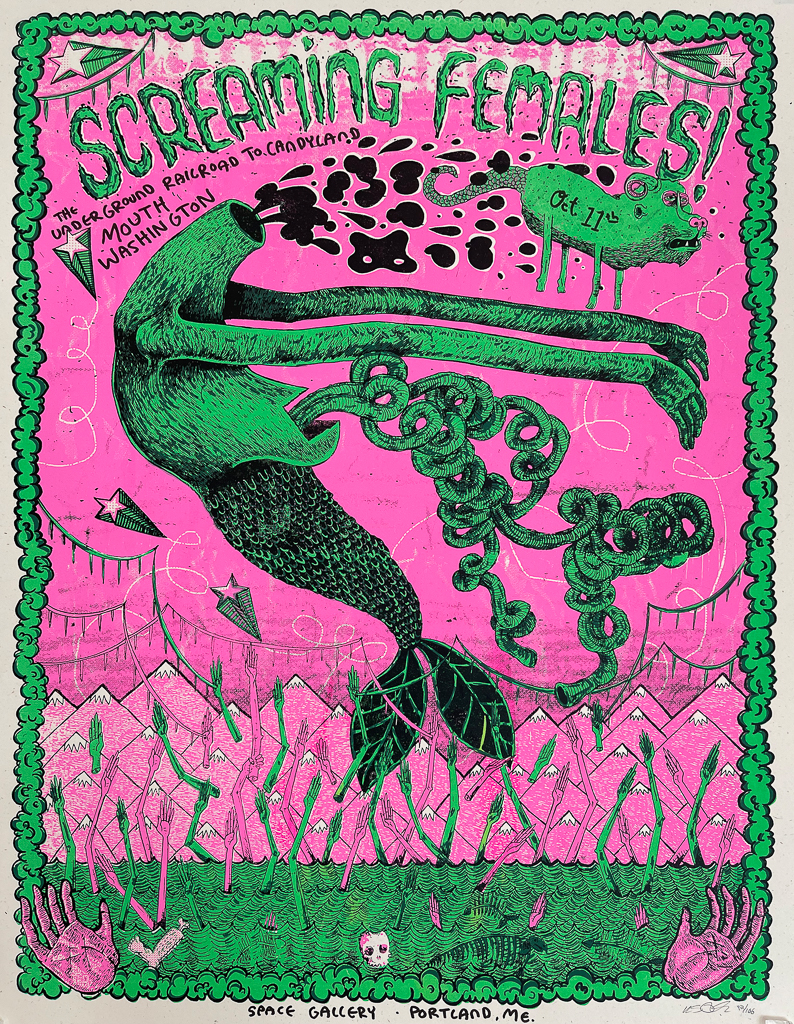
The Pony’s one, that was a weird acquisition, that poster was for an album release show before my time in Portland, I was living in Boston at the time. I eventually met those guys and I’ve seen them many times. That poster ended up coming through Pinecone & Chickadee, the store I work at. It was meant to be sold, and I was ‘like no way, I’m keeping that, that’s history’. I think it’s hand printed and then hand painted. It’s amazing. It was very random that it came through the shop, someone kept it, and I’m glad I have it now. I think the band did all the artwork on that. They used to do all their own stuff cause they were all MECA kids.
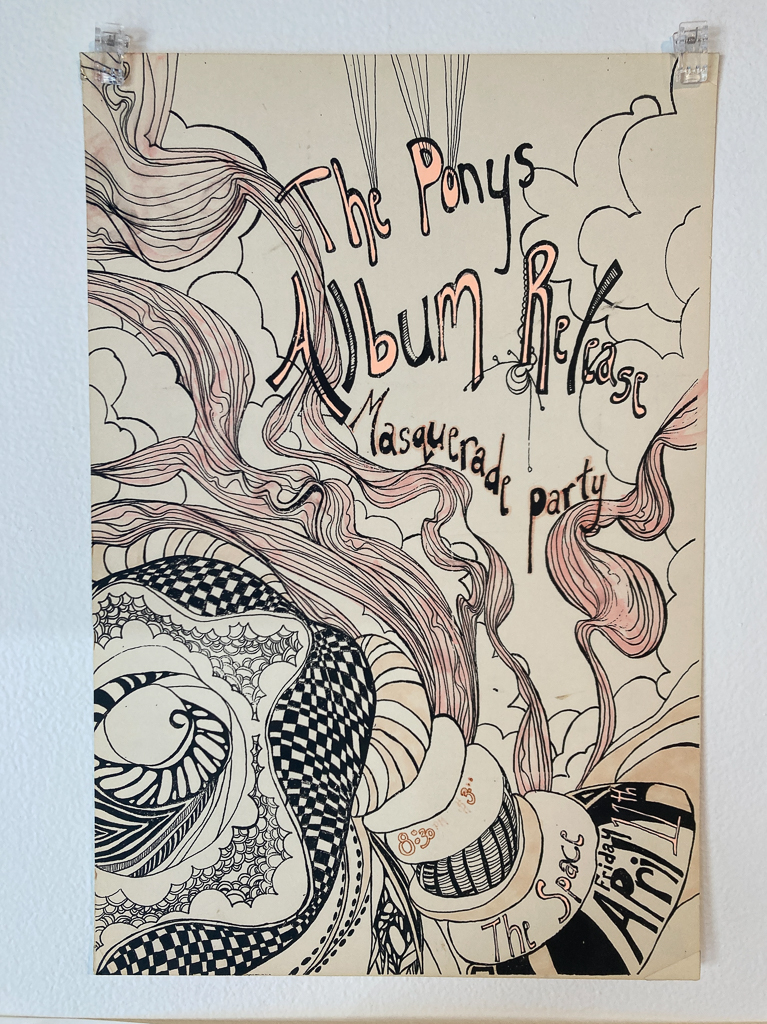
I’m gonna say the Feel It Robot one, which many people think I did but I did not, I just printed it. My friend Ryan LaMunyon did the art and I’m gonna say that’s the best poster ever made for SPACE. It’s so good. For a very short period while working at SPACE I was allowed to book shows but they were all ages shows. Back in the day the liquor license stuff was different, we couldn’t do all ages shows unless the bar was closed. We did 6 or 7 all ages shows during this period of time where we wanted to get either younger bands or ones that people are less likely to want to drink at, they were all $5 so the bands had to know this was an experiment, we wanted people to come, not necessarily make a lot of money off the shows. A lot of them went really well and we made posters for most of them to try to promote them. These were shows that I had helped put together more than others. It was super fun, and I learned I do not want to be an event programmer, it is very stressful. Feel It Robot was from Bangor, The 500’s were from here, Rotundo Sealeg were from here and it was just fun. Ryan drew that image and it is the band, we didn’t tell them that we were doing the image of them as robots and they saw it and were blown away, and I was too. They were very psyched. Remember in the late 90’s that song “Shaniqua Don’t Live Here No More”, by Little T and One Track Mike, Little T has played here before, he’s Tim Fite. The other guy, Michael Flannery, he moved to Bangor and he was in Feel It Robot, it’s a weird funny life connection. The night they played Ryan, the poster artist, was working down the street in a kitchen so he couldn’t come to the show right away, I remember the band came in and Michael asked who drew the poster and I said he’s coming later but he’s working, and the guy ran down the street, went into the kitchen and asked for Ryan and gave him a hug while he was cooking, and then ran back for the show. I saw Ryan later that night and it was so fun and random and amazing. So that poster has good memories but the art is just awesome.
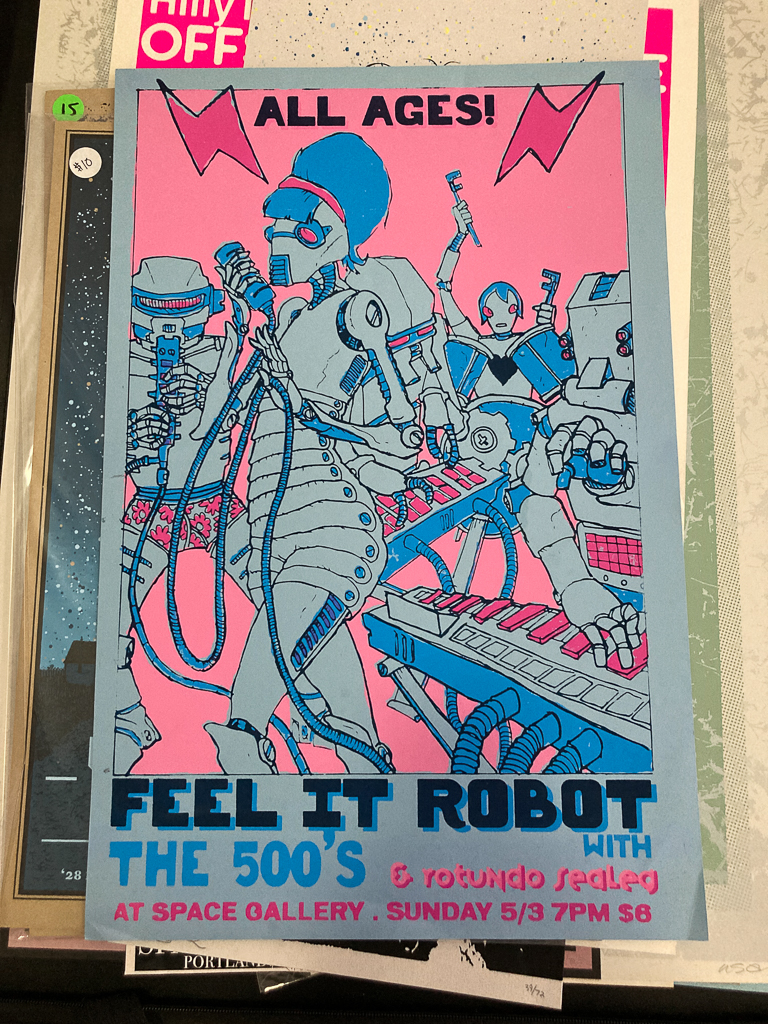
I like all of Reubens’ because he’s a huge inspiration to me. His band Ocean was a big part of my time when I started at SPACE. As a screenprinter he was very inspirational as someone who was just doing it, had a basic set up like I had and printed awesome posters. He’s a tattoo artist now and I’ve gotten tattooed by him a few times, I really looked up to him as someone local who does a lot of artwork and is very prolific.
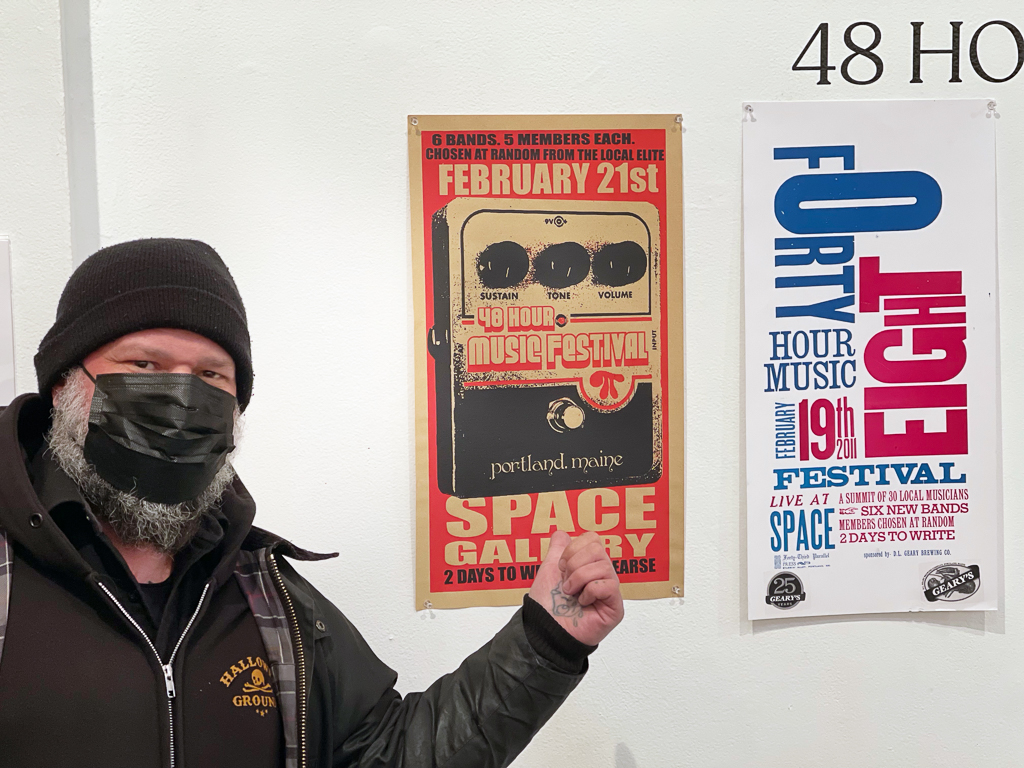
What has been your favorite live music at SPACE so far?
That’s a hard one. There’s some I don’t remember a ton, either because I was working on it and it’s harder to pay attention. Any show Brown Bird played, I don’t have a specific show memory of theirs, they played here a lot and every one was awesome and different. They were so nice and everyone that came to their shows was super nice. They were a band that everyone on staff came even if they weren’t working. So we were all there. I didn’t make a lot of posters for them and I don’t know why, I wish I did. One show that I remember was Deer Tick with Those Darlins and Tiger Saw. That was one of the most fun shows I’ve been to, at that time those bands were all kind of still new but also in their prime, it was the most fun drunk show I’ve ever been to. Everyone was really drunk, but like, happy. Very happy. No bad vibes at all. It was the right time to see those bands. Deer Tick is obviously still playing and they’re great, but something about that period of their career was different. Caspian with The Baltic Sea show was great. The bottom band on the poster Irepress dropped off the day before, which was fine because Arms and Sleepers, who had played here a lot and I’d become friendly with, they jumped on that day and were very awesome. Probably didn’t get paid any money and drove up from Boston, so they were super nice to play on that show. That was an all ages one too that maybe shouldn’t have been because everyone was well over 21 and like “What? We can’t get a beer?” But maybe people were able to pay attention more when it wasn’t a drinking atmosphere. Any Lady Lamb show was fun. Death Vessel, I loved seeing them, they fit with Brown Bird, they played together a lot. Any time Screaming Females played. It’s hard to pick one. As the years go by too, I saw shows before I worked here, I saw a lot of shows when I worked here and I see shows here now that I don’t work here anymore. There’s so many. I think my first show here was The Evens, which was Ian MacKaye’s band. Seeing a member of Fugazi as your first show here – I’ll be honest, I was just discovering Fugazi and that world- seeing that in person was eye opening because I wasn’t super familiar but the show was packed. Matt and Kim was one of the other first shows I saw here. Japanther was headlining and they dropped off the day of, and Matt and Kim were just getting big enough that they headlined and there were a ton of people here and it was so fun. Those are the early shows I remember. The first show I worked at was Fucked Up. I don’t think a poster got made for that, there’s very little documentation of that show. They’ve never come back to SPACE, they played Port City once. I could just keep going….
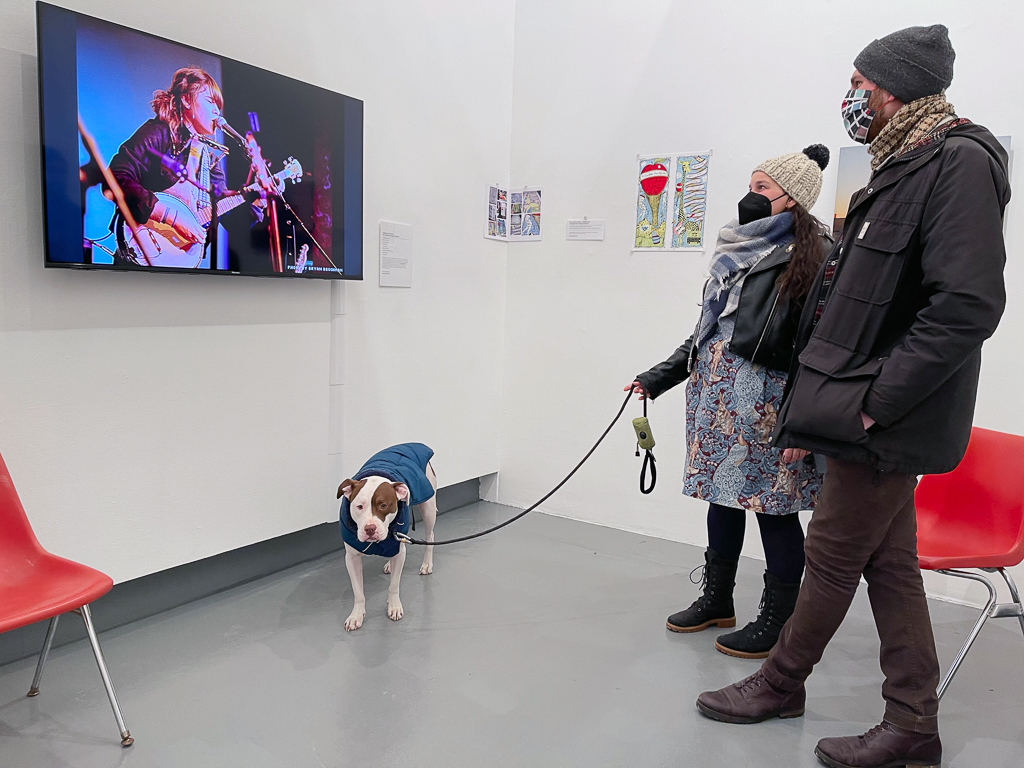
You’ve had a long relationship with SPACE, what do you think is going well with SPACE where it has arrived at now in its 20th year, and what critiques do you have?
It’s been interesting to be in town for so long and see venues still open, one, because a lot have closed. I am pretty attached to places, me and Jess met here, our first date was at Slainte, Slainte doesn’t exist anymore. I have a flier from our first date. There’s a flier in this show of the night I met her. Things like that connect for me which is super fun. I made a lot of memories here. When I worked here, there was a small crew of us and we just worked really hard for very little money, because that wasn’t what it was about. It helped that we were young enough that we didn’t have as many bills, Portland was a lot cheaper at the time and we just worked in a way that it felt like ten years but it was only four or five. When I worked here there was only the venue, no gallery yet, so it was a lot of art happening in one space. Even though I’m an artist I was slightly more on the music side of it, because that’s where my passion was and I could help out, using my art for the music or vice versa. Everyone found their own way to help. Music shows happened a lot, we worked a lot and it was super fun. Eventually we slowly got other jobs or naturally worked our way out. I don’t think anyone at the time was thinking ‘this is where we’re gonna be forever’ and that’s totally ok. Jess worked here before and after me. It felt great, the best times of our lives. I have no critiques really. I always viewed it as ‘we did our time here, we worked really hard, now it’s other peoples turn’ and things have definitely changed. The visual art part of SPACE expanded because previous to having the 534 gallery it was limiting. Even though our art shows at the time were amazing and pushed boundaries, it still had to be in an event space that 300 people were gonna come into. It’s always been interesting to see new people come in and I have a lot of memories here but I’m not sad I’m not still in it. I’m still making new memories at SPACE, I was here for events four times this past month. It’s a different experience now as someone attending the shows instead of working them, I can just enjoy it without thinking about the behind the scenes stuff. It’s always a place I run into a lot of familiar faces from my time in Portland as well. Those are the people I enjoy seeing the most and it’s nice to talk about past shows, many of them are featured in the GREENROOM exhibit.
Do you feel a sense of ownership of SPACE with your history here?
Not ownership. There was another generation of staff before me. I definitely feel really strongly towards the years I was here because it was a huge part of my life, and one of the main reasons I stayed in Portland after art school. More, looking back with fond memories and still making new ones. I don’t know if anyone can have ownership, cause no one owns SPACE, it just keeps going.
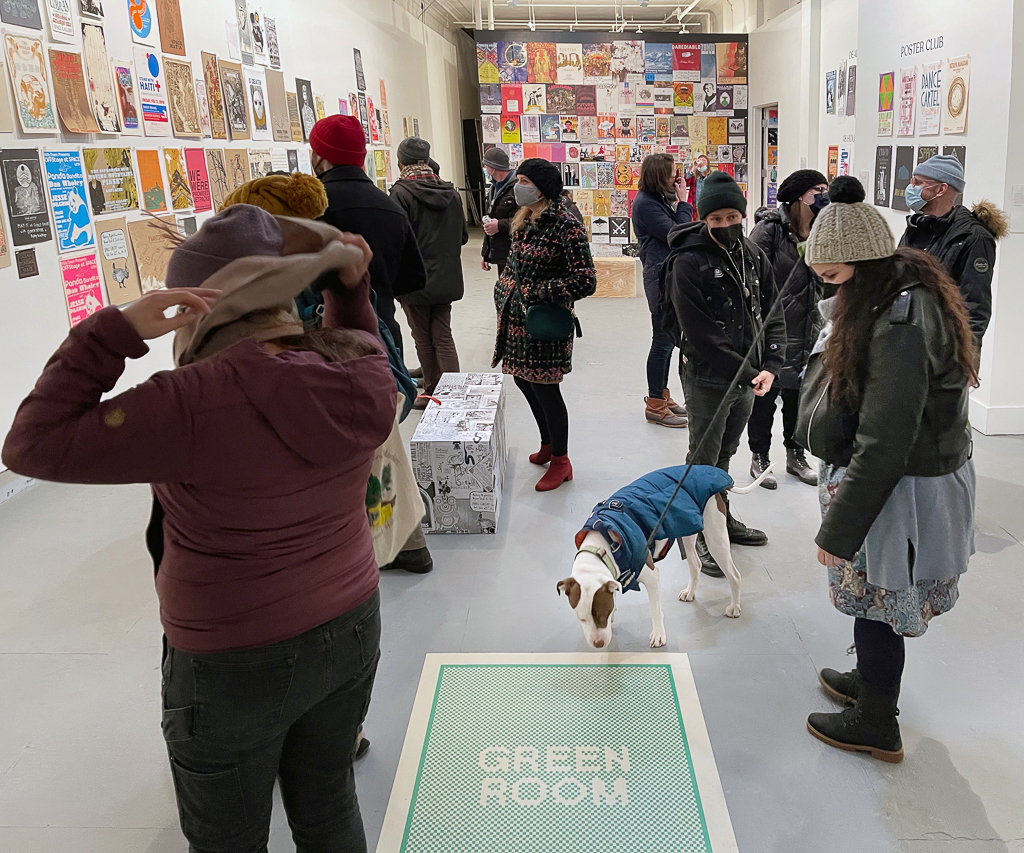
All exhibit photos by Carolyn Wachnicki

